Location: Rome, Italy
This famous quote by Michelangelo perfectly describes his work. He was a highly religious man and often referred to himself as the ‘took of God’, as only someone guided by the hand of God could create such beauty.
I couldn’t agree more. Sculptures have always called to me; I’ll gravitate to the junk of marble in the room before any paintings. In my non artist opinion, it takes more mastery, skill and talent to be a sculptor. If you make a mistake, it’s hard to recover. The painter, on the other hand, can simply paint over or wipe clean.
Rome is an exciting place to be if you enjoy sculptures. Every church, fountain and square is adorned with cRved works, some of which by the hand of the great masters, right there, in the open, for all to enjoy. And often it’s free as well! On another side note, my quest to view the best of Michelangelo & Bernini turned into an unexpected ‘Angels & Demons’ tour of Rome (clever fans will recognize the movie’s featured locations and artworks)!
Two such masters that have left imprints all over the city are Bernini and Michelangelo. Before we proceed any further, fair warning: this post is about art, sculptures in particular (in case you hadn’t surmised yet). If that doesn’t float your boat, best to read another post. And we might have to reconsider our friendship…. Kidding!
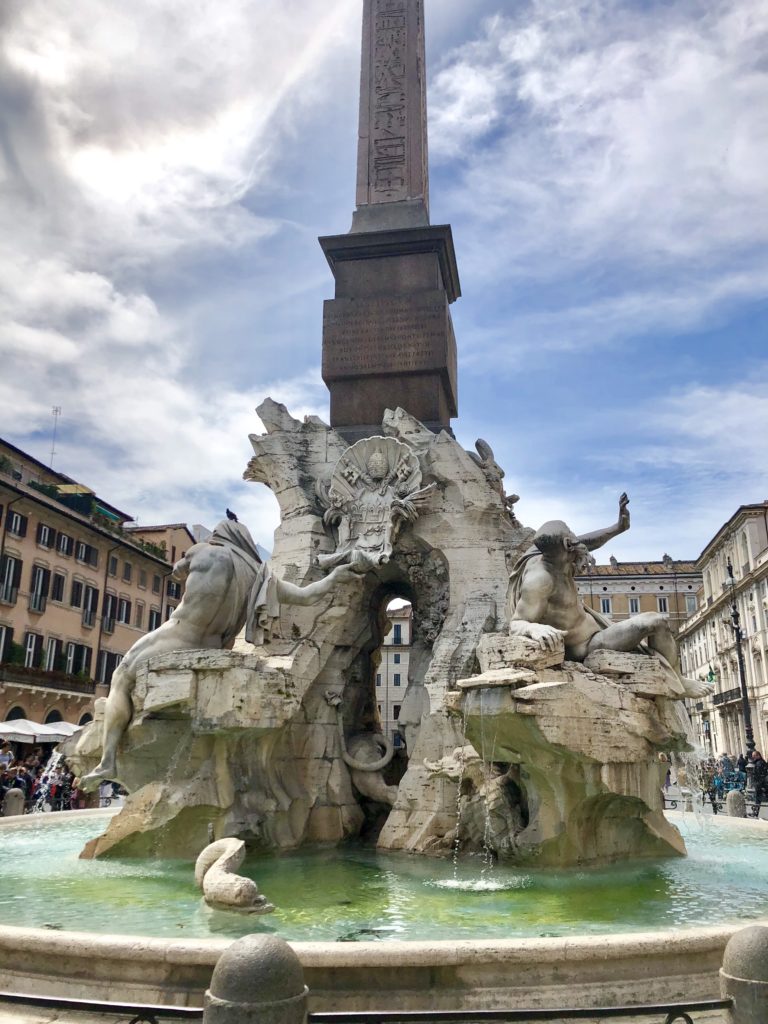
Piazza Novana is a famous square in Rome, featuring Bernini’s Fontana dei Quattro Fiumi Or Fountain of the Four Rivers (1651). Collectively, they represent four major rivers of the four continents through which papal authority had spread: the Nile representing Africa, the Danube representing Europe, the Ganges representing Asia, and the Río de la Plata representing the Americas (Wikipedia). To me, the beauty is the mixture of the highly sculpted and detailed elements with the raw and jagged, unpolished stone.
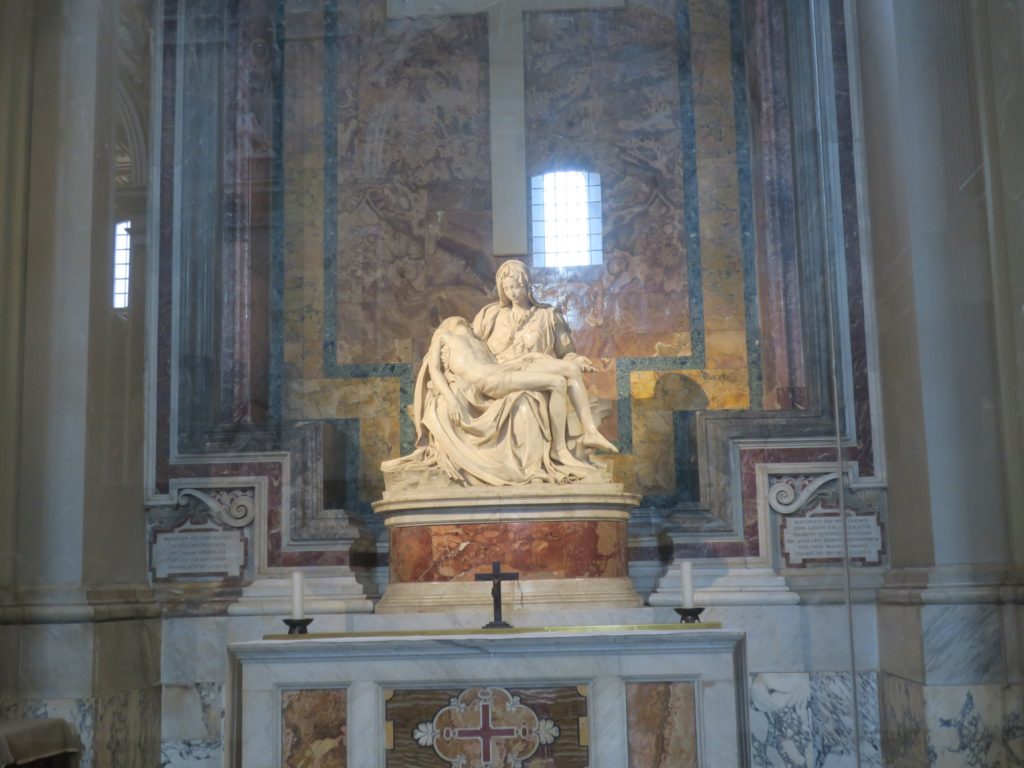
No post about sculptures in Rome would be complete without one of the most popular one: Michelangelo’s Pietà (1499). The massively impressive sculpture features a young Virgin Mary cradling the body of Christ after the Crucification.
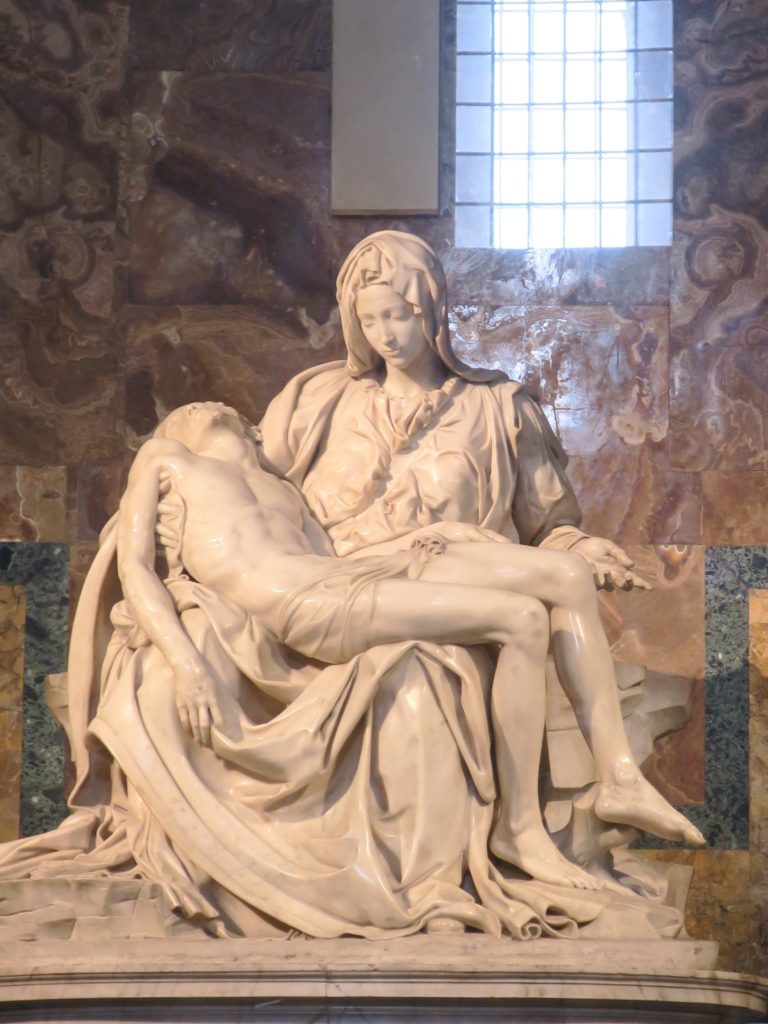
My words cannot do this piece justice (which is great for a blog, right?). At the time he created it, Pieta was considered unprecedented for its time; it balanced the Renaissance ideals of classical beauty with naturalism. This sculpture is jaw – droppingly beautiful. From the intricate folds of Mary’s dress to the limp figure of Jesus – perfection.
The other perfectly beautiful art by Michelangelo at the Vatican, is of course, the ceiling of the Sistine Chapel. When Pope Julius II asked him to paint the ceiling, the artist promptly said no. Why would he turn down a papal commission? As Michelangelo himself said: he wasn’t a painter. If that was the case, why then would the pope have even made the offer? It seems that the young artist (he was in his early thirties) had jealous rivals, mainly Raphael, who were itching to see him fail. They convinced the Pope to hire him in hopes that as he had never attempted a fresco before, would inevitably fail or, at the very least, become embroiled in a time-consuming effort that would remove him from the competition for years. The best laid plans….
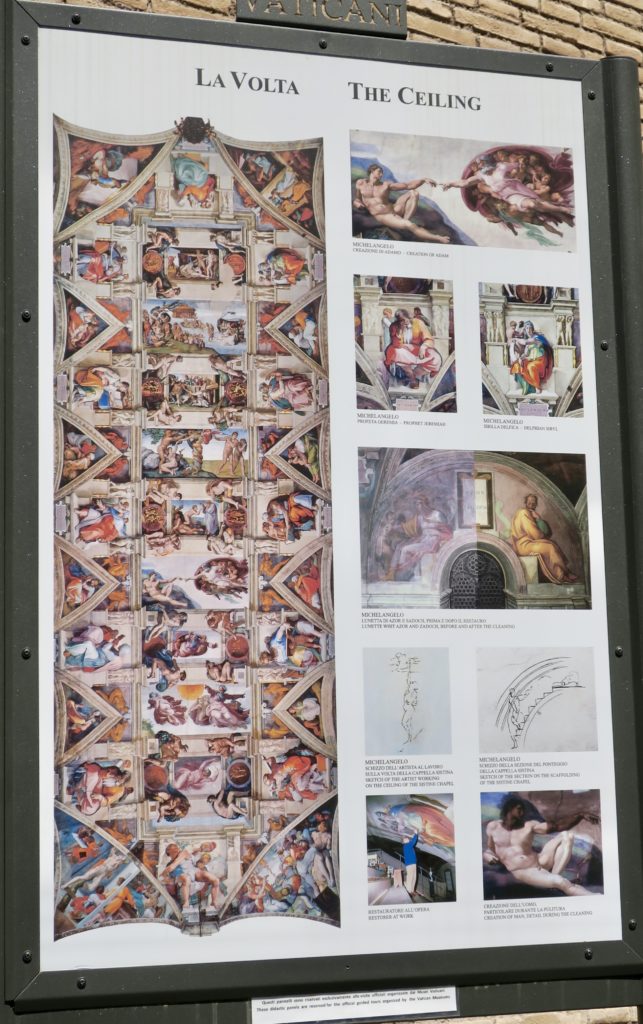
(Sadly, photos inside the Sistine Chapel are prohibited. An Italian television network sponsored the 20 year restoration and now own the rights to all images! On the bright side, it’s wonderful to be forced to soak in the wonder with your eyes and not your camera lens)
Upon entering the Chapel, one cannot help but be overwhelmed. Every surface, from floor to wall to ceiling is ornately decorated. The ceiling itself is decorated with saints and stories, chronicling 9 stories of the book of Genesis. Beyond the beauty of the paintings themselves, the creation of the ceiling is in itself a wondrous feat. Michelangelo had never painted a fresco (painting on wet plaster), and had to learn as he went. A special scaffolding had to be created in order to paint the 5000 square feet of ceiling. Despite popular belief, he did not paint while lying on his back; instead, he stood upright and painted the entirety of the ceiling by himself, over the course of 4 years. Imagine the pain he must have felt and the perseverance it required. (I hope he had a good physio!)
Years after the ceiling was painted, another Pope commissioned Michelangelo to adorn the wall behind the alter with yet another masterpiece: the Last Judgement.
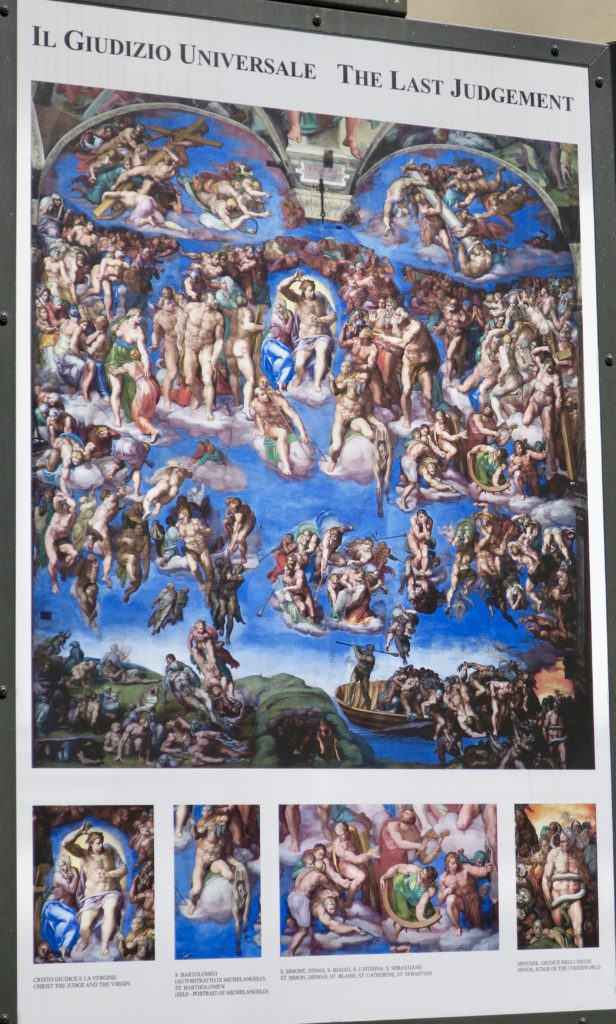 Fun fact: Michelangelo painted most of his figures nude however, after his death, many were scandalized by the flesh and one of his former assistants was tasked with making the masterpiece ‘modest’ (aka the ‘panty painter’).
Fun fact: Michelangelo painted most of his figures nude however, after his death, many were scandalized by the flesh and one of his former assistants was tasked with making the masterpiece ‘modest’ (aka the ‘panty painter’).
Centuries ago, it was the norm for Rome’s churches to be ornately decorated and many have spectacular pieces of art from some of the world’s most well known artists. One such church is Santa Maria della Vittoria. In one of the side chapel is the sculpture ‘The Ectasy of St. Teresa” by Bernini. The statues depict a moment as described by Saint Teresa of Avila in her autobiography, where she had the vivid vision of a angel piercing her heart with a golden shaft, causing her both immense joy and pain. The flowing robes and contorted posture abandon classical restraint and repose to depict a more passionate, almost voluptuous trance. (Wikipedia).
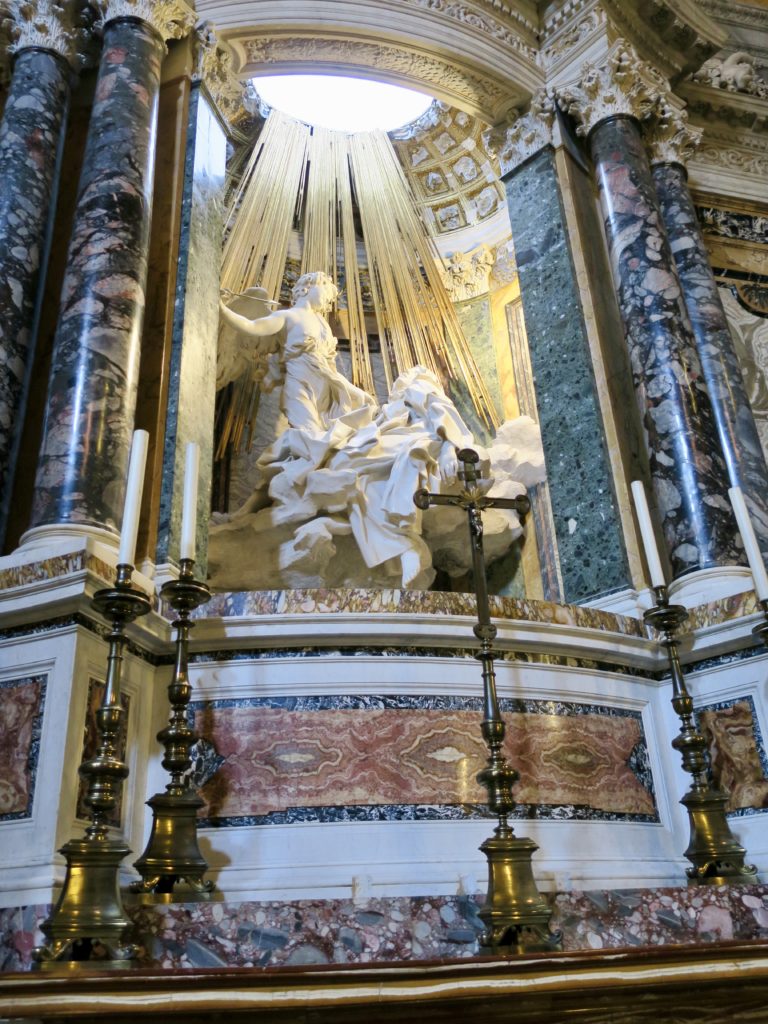
In its recessed position, the marble is illuminated by a golden light, casting a captivating glow over the scene. The raw emotion in the saint’s face transcends the stone and comes to life. Impeccable.

Another impressive Roman church is Santa Maria del Popolo, home of not only a Bernini sculpture, but a Caravaggio masterpiece.
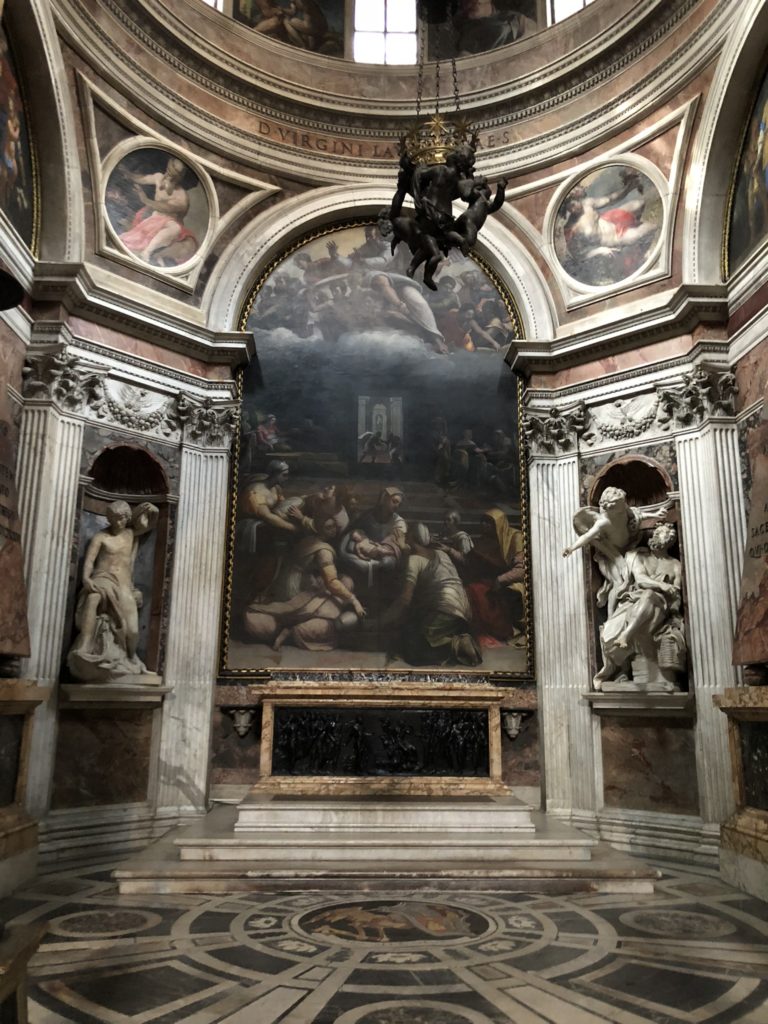
Chigi Chapel, with Bernini’s sculpture (right): Abacus & the angel. Just right there, in the open, where anyone can admire it. The detail of his work continues to astound me.
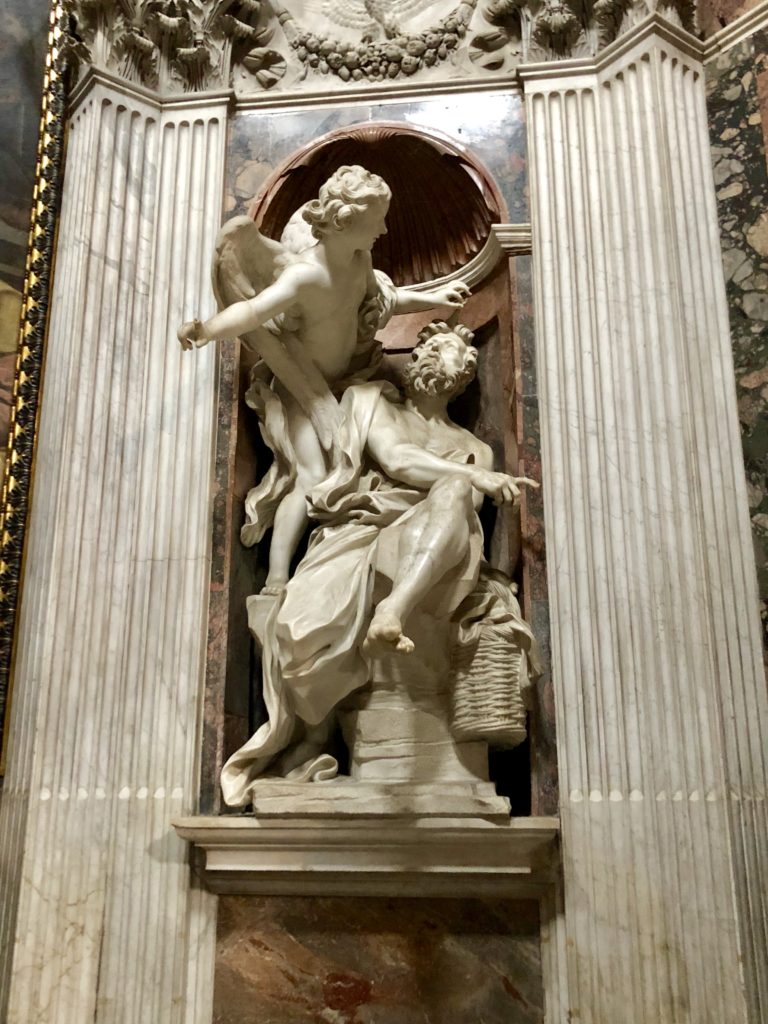
Bonus: while this obviously isn’t a sculpture, I’m throwing in this painting by the renowned Caravaggio: Crucifixion of St Peter. Found in a corner chapel in the church, this piece is quite simply, exquisite. A marvellous example of Caravaggio’s mastery of light, it depicts de the moment just before St Peter’s crucifixion, a popular theme at the time. This masterpiece is absolutely free to view as it is in a church (there’s no admission fee to any church in Italy, St Peter’s included). However, it is kept in a dark corner and for the generous contribution of a two euro coin, the painting is illuminated. Pro tip: wait long enough and someone will cough up the change. How ever, be courteous and get out of their way soon after; they did pay for the privilege after all.
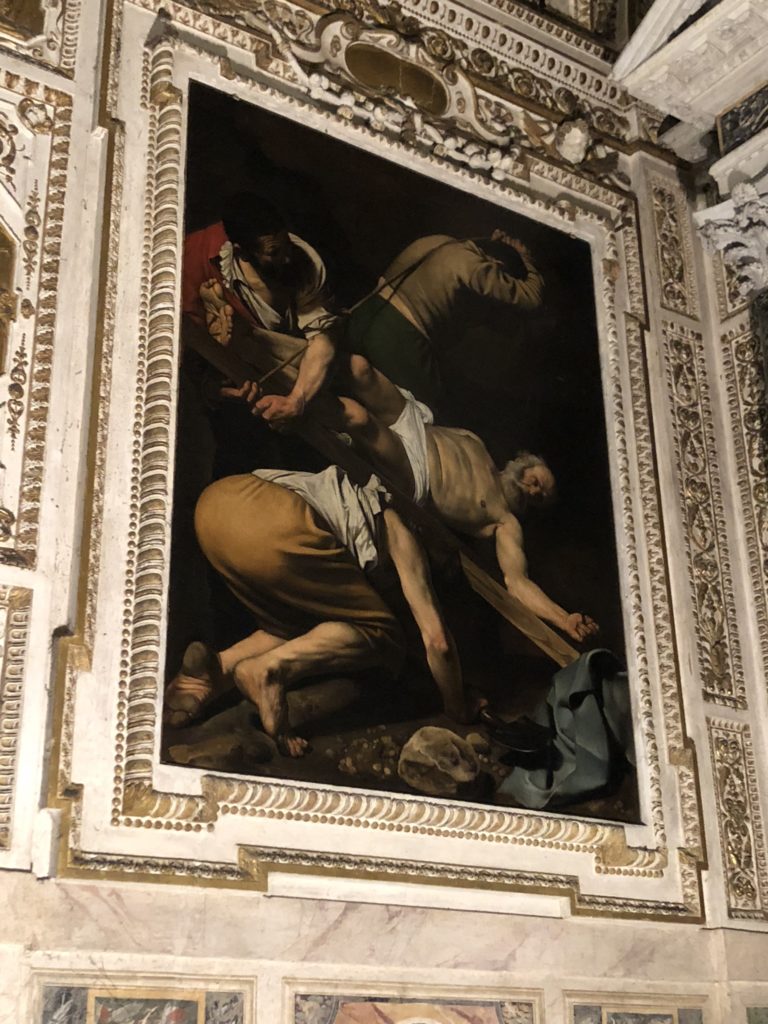
I had long wanted to visit Rome, it’s history, culture and of course, it’s cuisine! However, there was another reason I longed to set foot in the Eternal City: The Borghese Gallery. I have always gravitated towards sculptures over paintings, however, after I took an art appreciation course some years ago, my love affair with marble was cemented, so to speak. I discovered the genius that is Bernini and longed to see some of his earlier work. Primarily, the sculpture entitled ‘Apollo & Daphne’, the very last piece he would complete before working exclusively for the Catholic Church. Seeing this sculpture was the #1 thing on my Rome ‘to-do’ list. Pro tip: get your tickets ahead of time! I narrowly missed out as tickets are for timed entry and quite limited.
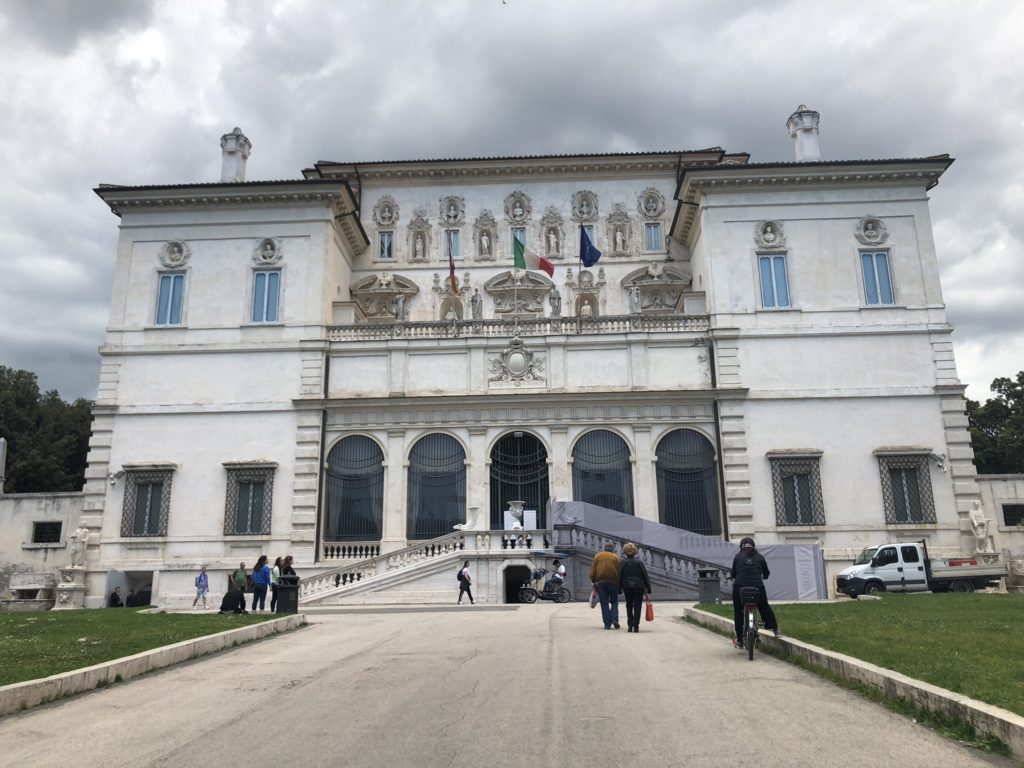
The Borghese Gallery was never a private residence; it was built by the nephew of the Borghese Pope to display their impressive art collection and has served in this purpose since the 1600’s.

The ‘Rape of Persephone’, created by Bernini when he was only 23 years old is awe inspiring. I mean, quite literally, stopped me in my tracks, jaw on the floor, breathtakingly beautiful. It depicts the Abduction of Persephone, where Proserpina is seized and taken to the underworld by the god Hades. Her mother, Demeter, is grief stricken by this abduction and refused to allow the soil to grow anything. Finally, Zeus, pressed by the cries of the hungry people and by the other deities who also heard their anguish, forced Hades to return Persephone. The compromise: Persephone would spend 3 months of the year, every year, in the underworld (hence, winter).
The impressive setting, decadently marbled and gold leafed, only serve to highlight the impressive nature of this work. The attention to detail by the artist is unprecedented: Hades fingers are digging into the ‘flesh’; the corner of Hades’ eyelid is stretched as Persephone uses all her strength to push against his face; the muscle tone & definition, the anatomy clearly outlined. One must continually remind oneself that this is stone, and not clay covered human bodies. Life I said, I stopped in my tracks and spent the better part of the hour gazing adoringly at this masterpiece.
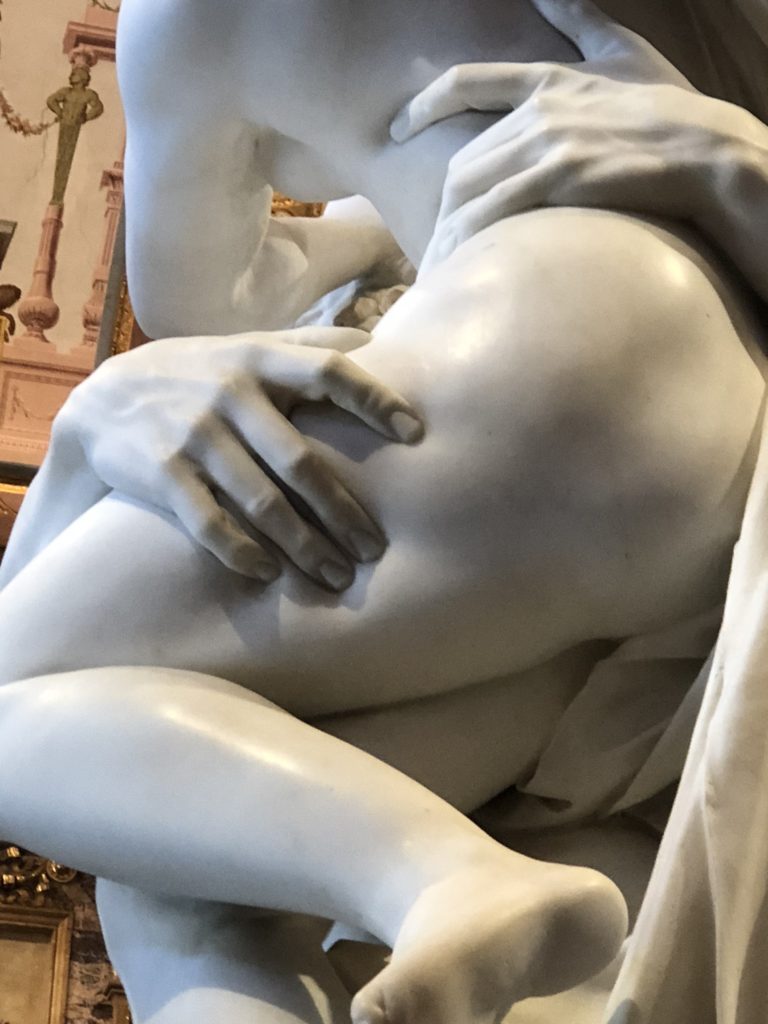


Finally, it was the moment I had long waited for: I came face to face with Apollo and Daphne, one of Bernini’s greatest works. Apollo, the god of music, poetry, art, the sun and a great warrior, mocked the god of love, Eros (Cupid), for his use of bow and arrow, as Apollo is also patron of archery. The insulted Eros then prepared two arrows: one of gold and one of lead. He shot Apollo with the gold arrow, instilling in the god a passionate love for the river nymph Daphne. He shot Daphne with the lead arrow, instilling in her a hatred for Apollo. He continually followed her, begging her to stay, but the nymph continued to reject him. As he grew closer, Daphne pleaded to the gods for help to escape Apollo once and for all. At the very moment he was about to catch her, Daphne turned into a laurel tree. The sculpture captures the transitional moment, caught between women and tree.
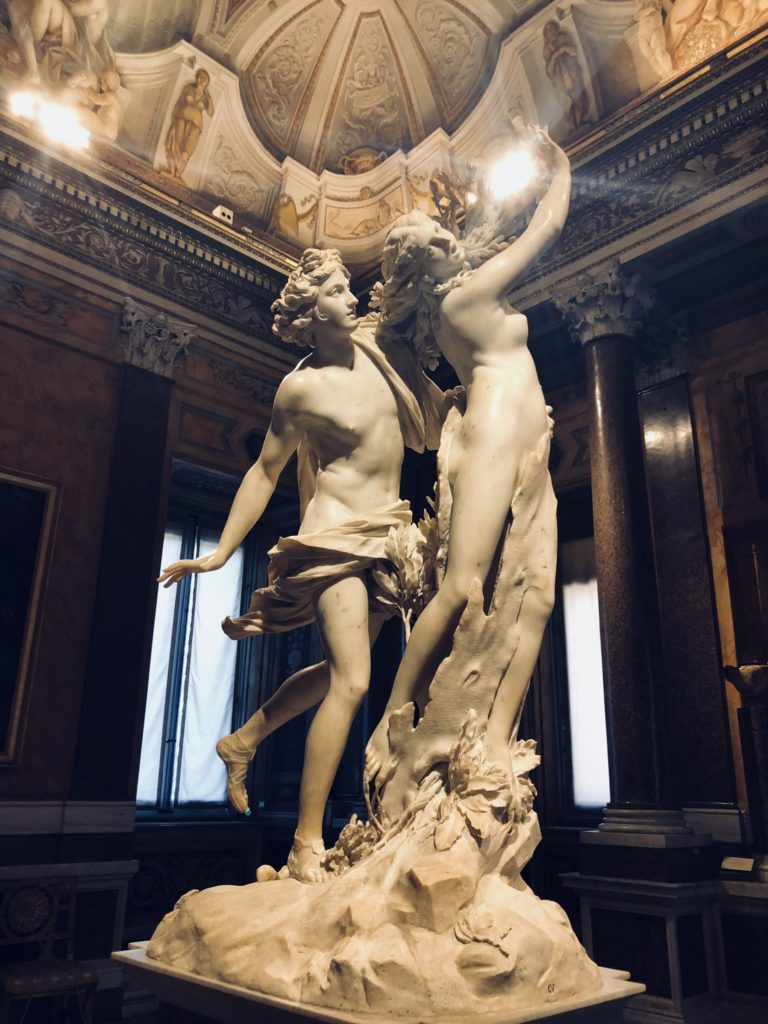
While the anatomy and physiological attributes are not as impressive as the previous work mention, the symbolism and attention to detail is beyond comprehension. Daphne fingers have transformed into delicate branches, leaves burgeoning.
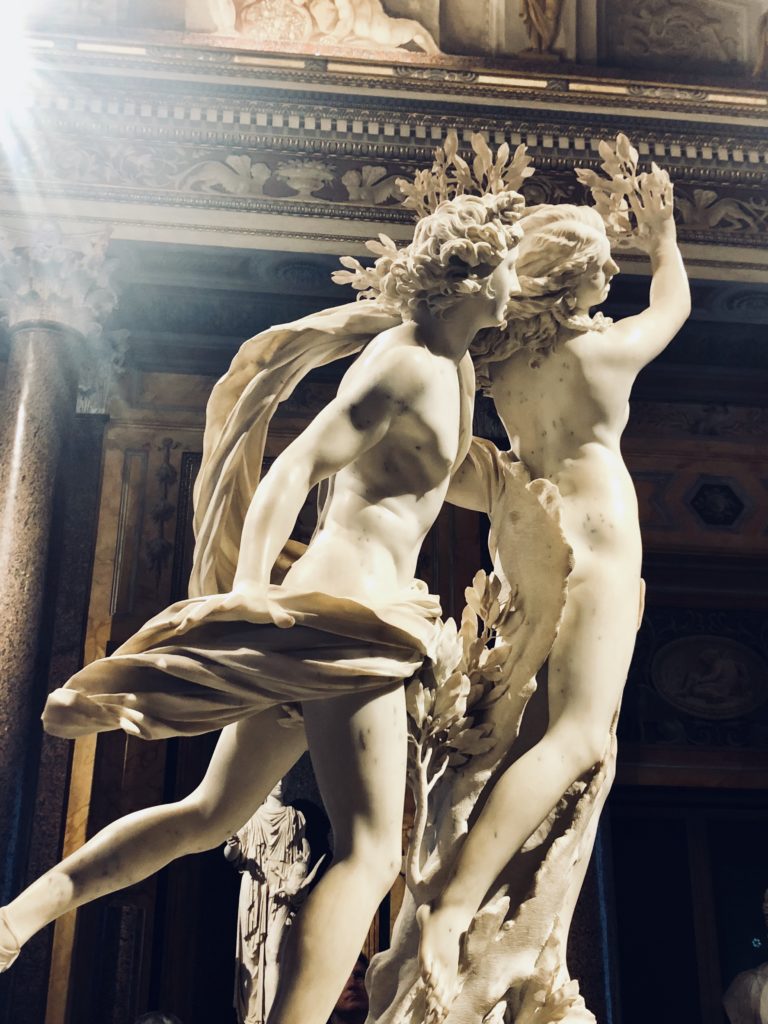
From one side, Daphne’s hair is caught in a moment of flight, windblown and free; seen from the other side, sculpted bark of a tree.

Apollo’s tunic caught in a wind gust, floating delicately away from his body. It’s incredible to thin that this was sculpted from a single piece of imperfect marble.

Another piece of incredible detail: While it appears on the surface that Apollo has ‘caught’ Daphne, he is in fact touching the part of her that has become the tree. To the very end, the God is refused the pleasure of touching her flesh.
There is no better feeling than having your high expectations surpassed. I couldn’t tear myself away from the two amazing creations in the Borghese Gallery, bouncing back and forth between the two rooms, my eyes capturing new details with every visit. In the end, I was left in quiet reverence at this artist’s extraordinary talent, truly grateful that I had been blessed to witness such beauty with my own eyes. Isn’t travel amazing?

Julie,
Wow!!! What a beautiful blog and photos! Unfortunately, I never got to go to the Borghese gallery when I was in Rome, the sculptures there are truly wonderful!!!